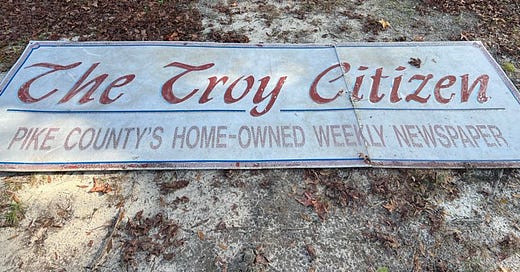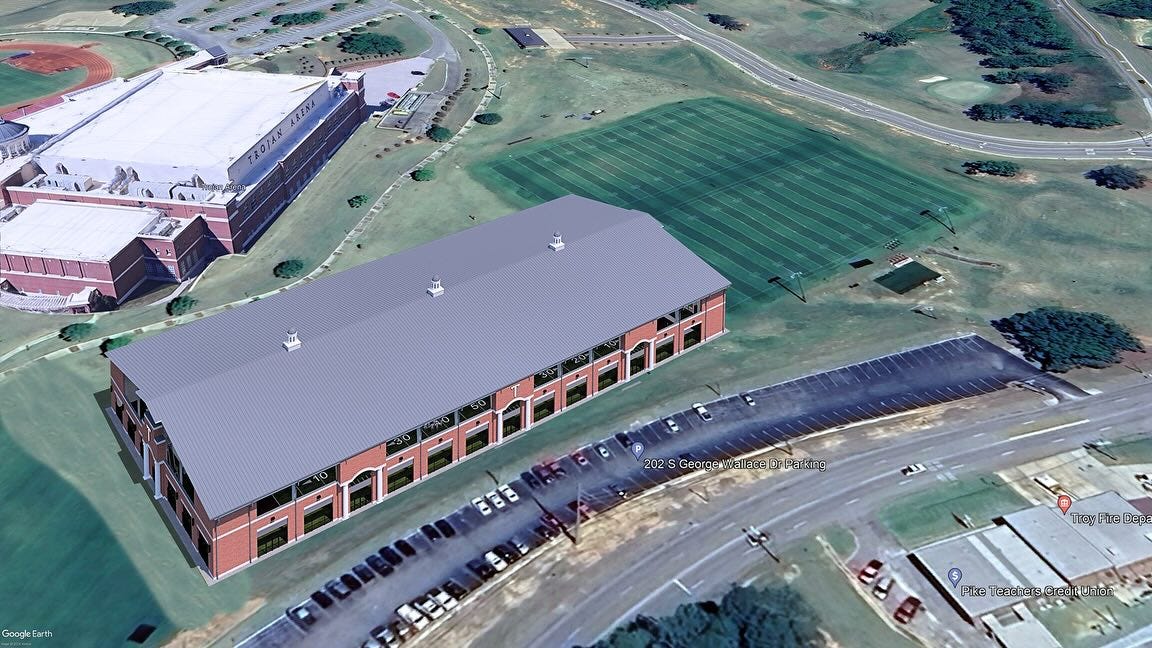The Back Story of The Troy Citizen
The changes in the newspaper business in the past 30 years are staggering. Plus, great artist renderings of the Troy indoor football practice facility.

By BILL RICE, JR.
Jerry Beckett asked me to speak at tomorrow’s Troy Exchange Club meeting about the launch of the “re-booted” Troy Citizen.
What I think might be interesting to local citizens is how much the newspaper business has changed in the 29 years since my brother Bobby and I started the original Troy Citizen in 1995.
For example, much of the labor-intensive work of producing a newspaper has largely disappeared - and someone like me can launch an on-line newspaper for the grand total of $0.00.
(I won’t divulge how much money we had to borrow from the bank and raise from investors to launch our weekly print newspaper, but it was a lot of money even then.)
Each week, I would work at least 80 hours trying to get out that week’s newspaper.
While my title was “publisher,” I was also a seller of ads, a business manager (probably not a good one), a staff reporter who wrote 10 or so stories for every edition … and I helped Joanne Wells and Joey Burkhart lay out the paper.
I also drove the paper to the printer in Andalusia and when, I got back at 11 p.m., took a paper route and rolled, bagged and threw 1,000 or so newspapers.
(Just writing this partial job description re-activated my post-traumatic stress syndrome.)
In 1995, we printed newspaper pages in three sections and then ran these pieces of paper through a waxer and “pasted up” the pages on broad sheets.
Our journalists didn’t write every story. Many press releases were faxed to us, which meant someone had to typeset these articles (honor rolls, school lunches, calendar items, news briefs, etc.)
God bless the inventor of e-mail …
More than anything else, the invention of email transformed the newspaper business as editors can now simply “copy and paste” press releases and do minor editing as needed.
Today, of course, people can also email photos. In 1995, we used a flat-bed scanner to scan prints of photos.
When I started in the newspaper business in 1990 (as the sports editor of The Troy Messenger), The Messenger had a dark room and one of our writers doubled as the film developer.
At about 3 p.m. each afternoon, I’d hand Doug Paramore one to five rolls of film (anyone remember those canisters?) and after Doug printed the negatives I’d look at them though a loop and tell him which shots I wanted him to print.
I’d then crop the photo with an exacto knife, put one-point line tape on the photo border, wax the photo and put the print somewhere on the page after I had “dummied” the sports pages. (Dummies were pencilled chicken scratch showing where all the stories and headlines were supposed to go).
I did all this after I’d done four to five interviews (usually by phone) and then speed-wrote four to seven stories … and then wrote the headlines and captions, which I had to print, crop, wax and paste up separately.
Wal-Mart was our dark room …
When I started the Citizen, we didn’t have a dark room so we just bought color film every week. After myself and our staffers had played roving photographer for a week, I took the negatives to the Enterprise Wal-Mart every Sunday afternoon (as this was the nearest place with “one-hour” film processing.)
Our photographers might take 24 to 36 photos of which we might use four or five decent ones in the newspaper. (With a few exceptions, all the photos were printed in black and white).
So it probably took six hours of work (and 70 miles of round-trip driving) to get 20 or so useable photos into the newspaper. And I had to pay Kodak for all the rolls of film and Wal-Mart for film printing … plus gas.
Today, I snap a photo on my cell phone (a camera is not even required) and can instantly look at my photos, pick the best ones and email them to my desktop computer.
In 20 seconds - for no charge - I can have a photo on the “screen” you’re looking at right now. Indeed, anybody in the world can look at that photo in a matter of seconds.
I don’t have to drive to Andalusia in a rented U-Haul to get the paper printed because there’s no printing involved. I certainly don’t have to roll and throw any newspapers, nor do we have to sort newspapers by zip codes for the papers we mailed to out-of-town subscribers.
My printing bill has gone from gulp-inducing to … zero.
We were a small business, but I still had a payroll to meet …
At different times, The Citizen might have had six to 10 paid employees (not counting the 10 or so people I paid to throw newspapers every Tuesday night).
This doesn’t count my mother, who worked as our office manager for free or myself, who ended up working essentially for free. (A well-known business fact I quickly learned: Business owners get paid last).
To pay these many expenses, a newspaper publisher has to sell a lot of advertising.
Since I raised the white flag and closed The Troy Citizen (and Pike’s Peek) in 2003, several people have asked me why I closed this newspaper, which, I think, was always popular with readers.
The answer is we never sold enough ads to make any profit. I was constantly pulling rabbits out of the hat to keep the paper on the street.
(Whenever things started to look bleak, I’d publish a “special edition” like our very popular “Reflections” history edition, which made more money in one edition than 10 regular editions did).
As I belatedly learned, the key to the operation in the small-town newspaper business is to have pre-sold ads where you could count on $X revenue coming in every week. Otherwise, you’re starting from scratch every week.
In the newspaper business, you’ve almost got to have full-page grocery store ads … which The Citizen never had.
The reason Bobby and I started The Citizen is because Don Herring had closed the weekly Troy Progress (or actually sold it to The Messenger’s parent company, which later closed it).
I worked for Don (and his wife Karen) for a year or two as a writer at The Progress. This was enough time to see that Don was a bionic ad salesman (the real MVP of any newspaper).
I think Don would agree with me that the biggest event in the history of The Troy Progress was when Mrs. Ingram, the owner of Ingram’s Curb Market, agreed to run a full-page ad in every edition of his newspaper.
Because she did this, all the other grocery store owners or district managers with Troy grocery stores felt they also had to have ads in the same newspaper. So one full-page weekly ad quickly produced four full-page weekly ads.
Don also got the car dealerships to buy big ads on a routine basis … and pretty much every well-known business in town.
If I remember correctly, a typical edition of The Troy Progress was 24 to 36 pages … and at least 60 percent of those pages were print display ads.
People would sometimes ask how do you make money from a “free” newspaper - well, this is how you do this. The “inserts” stuffed inside the pages were gravy for a newspaper publisher.
When I started The Citizen, I followed Don’s model, but since we never got any full-page grocery store ads and I was paying to print 12,000 editions that our carriers threw to practically every home in Pike County, The Citizen’s bottom line - almost from Day One - was disconcerting.
But there’s always a work-around …
My work-around was to switch to a paid subscriber newspaper, which would produce new subscription revenue while also cutting our printing bill by 75 percent.
Troy Citizen citizens might also be interested in learning how we sold our initial subscriptions - a technique we couldn’t use today.
What I did was hire a man from Tennessee who specialized in newspaper “subscription drives.” This man had an ingenious formula. What he did was hire college students for a week who then called every single person in the Pike County phone book!
“Ma’am, good evening, this is April from The Troy Citizen. Would you like a year’s subscription to Pike County’s locally-owned newspaper?”
Today, such tele-marketing wouldn’t work … because nobody has a land line phone!
In 1996, however, this strategy generated 3,000 paid subscribers in about a week.
I also could lay off eight or so of my newspaper carriers as we were now distributing 3,000 newspapers instead of 12,000 (and I took the Hillcrest paper route).
Because we were now a “paid-circulation newspaper” - after waiting 12 more months - we could also sell “legal advertising” (like foreclosure notices, divorce announcements, etc). This new revenue stream and the subscription revenue kept us in business six more years.
Eventually, I got tired (aka “burned out”) and, one day, I heard a radio commercial on a Cumulus radio station saying this national radio chain was looking for new advertising sales reps in Montgomery.
By this time, by default, I’d become the closest thing to Don Herring in The Citizen’s clubhouse and a light went off: “Heck, I could sell radio commercials just as easy as I sell print ads.”
By then I had a cell phone and, on the spur of the moment, I dialed the number provided in the commercial.
I spoke to a Cumulus sales manager named Joy Melton, who told me to come see her in downtown Montgomery the next day … and she hired me that day.
(See … advertising works! But it works best when someone has had a “triggering event.” My triggering event was that I needed a change and a break from producing a weekly newspaper and this was my instant solution.)
Epilogue …
For two years I did pretty well selling radio commercials, which was a 9-to-5 walk in the park compared to my previous Stress City job.
Most importantly, I met my future wife, Carrie, who briefly worked for Cumulus … so the Lord does work in mysterious ways. (I would have never met the right girl working 80 hours a week at The Troy Citizen).
Nobody’s asked me why I got back into the local newspaper business … but if you’ve read this far, I think you know the answer.
Just about everything that once stressed me out about the newspaper business is now easier by a factor of 10. Also, every expense I had has magically disappeared.
Today, I’m producing the “re-booted” Troy Citizen in my house from one computer (sitting on a hand-me-down card table), one cell phone and no employees.
Since I closed the original Troy Citizen, the newspaper industry has gone from potentially lucrative … to challenging … to dire … to bleak and, today, most newspapers are existing on life support.
But the sad economics of the newspaper industry - and how these changes affect communities and the world - is a story for another day.
The good news is that a market still exists for original and compelling local stories … and, as it turns out, fewer and fewer people work in the profession to tell these stories.
Which means I can still do the same work I did in 1990 or 1995 - and 90 percent of the labor formerly required to produce such content - and 95 percent of the stress - has gone somewhere with the wind.
(I’m still selling subscriptions with the re-booted Troy Citizen - however, they are optional. So far, about 16 percent of our subscribers are supporting this venture with a paid subscription. All subscriptions are greatly appreciated.)
+++++++++++++++++++++++++++++++++++++++
Troy Indoor Practice Facility is going to be beautiful …
Troy University is one of the few Division I football programs without an indoor practice facility. However, this will change in about a year when work is completed on a new practice facility that will be located just above the two larger practice fields between Trojan Arena and George Wallace Avenue.
Work is slated to begin in January. I recently found these artists renderings of the facility at the Troy Trojans Football Facebook Page and thought readers would be interested in viewing them.








Aww. I feel that nostalgia when I run across my old business cards I had when I owned my own pharmacy. I think I’d just keel over in shock if someone found an old sign! I still have all the newspaper stories done on me and my little store. My local paper was good to me (and we did spend some serious money advertising in them as well). How nice to have that sign! Jealous!!!
What an incredible story to tell. Alabama is truly blessed to have you as one of its sons. thank you for all you do. You're a good man, bill rice and Lord knows.We could use more like you right now.
a very Merry Christmas and Happy New Year to you And your family. May the good lord bless and keep you in the coming years.